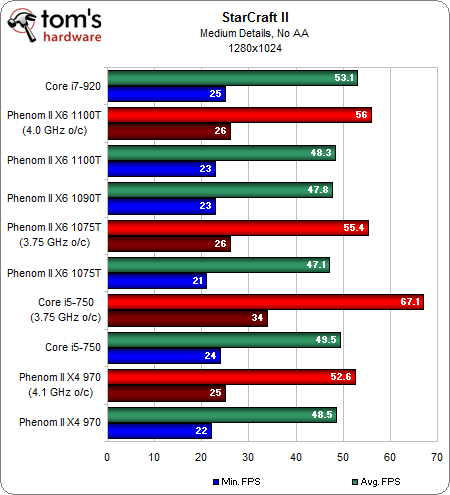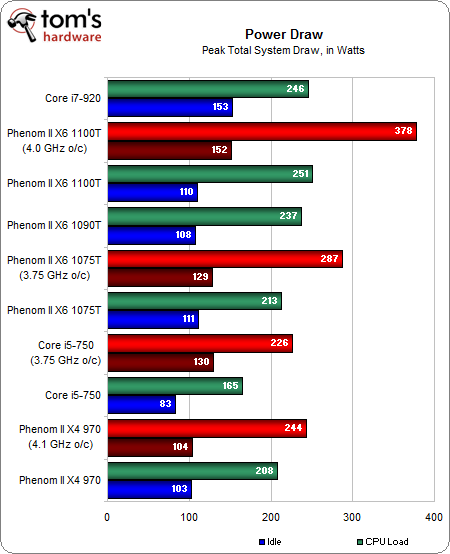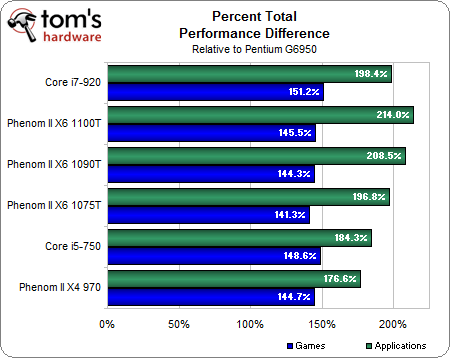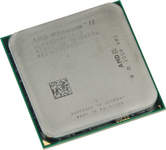|
TopNax |

AMD Phenom II X6 1100T Review: The New Six-Core Flagship
|
|
Page2
|
|
Benchmark Results: Games
Crysis is limited by the power of our reasonably powerful graphics card across the playing field. None of these processors demonstrate any obvious weaknesses, but thereís a slight advantage in favor of the Intel CPUs.
The DiRT2 test also results in a virtual tie.
Our Tomís Hardware StarCraft 2 Benchmark is very CPU-limited, but that doesnít translate to a significant difference in results across these processors. The Core i7-920 does perform a little stronger than the other models, though.
Benchmark Results: Multitasking
We test multitasking prowess by running the Crysis benchmark at the same time that WinRAR compresses a large archive.
All of the processors have at least four CPU cores, and no product shows any obvious weakness here. The Intel CPUs sacrifice slightly less performance in a situation like this one, but the Phenom II X6 processors also stand up well in this test.
Overclocking Weíre always interested to see if new processors might be better overclocking candidates than the older versions, and to that end weíre pushing the Phenom II X6 1100T to the limit. Unfortunately the result isnít especially encouraging, with a 4 GHz final result using a 20x CPU multiplier combined with BIOS settings of 1.5 V for the CPU and 1.4 V for the CPU northbridge. The memory managed to hold at 536 MHz with low 7-7-7-16-27 timings. This is the same CPU overclock we achieved with our Phenom II X6 1090T in a previous overclocking article, so while it's a respectable result for a Phenom II X6, weíre not particularly impressed with the potential of our new sample. Here are the test results:
The overclocked Phenom II X6 1100T manages to push its way past the stock Core i7-920 here, but the overclocked 3.75 GHz Core i5-750 pulls a much higher Dhrystone result and shows why Intel is such a formidable opponent in the overclocking arena (gotta respect the manufacturing technology advantage there). Nevertheless, the overclocked Phenom II X6 1100T manages to achieve a much higher Whetstone score than the overclocked Core i5-750.
The DivX codec shows a large performance increase with the Phenom II X6ís hexa-core architecture, but the Xvid codec prefers raw speed and Intelís processor architecture. The overclocked Phenom II X6 1100T beats all of the stock processors here, but the overclocked Core i5-750 scores a clear win when it comes to Xvid encoding. Note that the overclocked 3.75 GHz Phenom II X6 1075T performs just as fast as the 4.0 GHz Phenom II X6 1100T in this test, probably because of the 1075T's overclocked 250 MHz bus speed compared to the 1100T's standard 200 MHz bus.
As we said previously, our StarCraft 2 benchmark is CPU-limited. The game does respond very well to Intel Core i5 overclocking, but the Phenom II CPUs donít show much of a performance increase when pushed to 4 GHz.
Power Benchmarks
At its default clock/voltage settings, Intel's Core i5-750 uses a lot less power at both idle and under load than the Phenom IIs, despite the fact that both processor families are etched at 45 nm. The Core i7-920 is an early Bloomfield sample with a more complex memory controller and a complementary platform based on two chipset components, rather than one. As a result, system power consumption on the -900-series chips is almost always going to look higher than the Lynnfield- and Clarkdale-based parts. The overclocked Phenom II X6 1100T blows the roof off of maximum power usage when overclocked, though. This is a surprisingly high result, and we ran the test multiple times to ensure its validity. It's a good thing that, the same chip at its stock settings, is much more power-friendly
Conclusion: Take It To The Limit One More Time
Yes, the AMD speed bumps are here again. In what has almost become a bi-monthly tradition, we're starting to take the company's increasing clock rates and seemingly-static price tags for granted. Unfortunately, we can only overclock our Phenom II X6 1100T sample to 4.0 GHz. While this is a respectable speed for a hexa-core CPU, itís the same ceiling that our older Phenom II X6 1090T would hit. When you consider that the realistic cap for the Phenom II X6 CPU on air cooling is around 4 GHz, and that the Phenom II X6 1100T's Turbo CORE clock is already set to 3.7 GHz, it's pretty apparent that these speed bumps can't go on forever. In fact, we remain convinced that the Sandy Bridge launch will put even more pressure on AMD. What can the company do at that point? It's hard to say. Having said that, AMD offers plenty of entry-level processors that could be scaled up to run faster at similar prices, if it needed. The Athlon II line is capped much closer to 3 GHz at the moment, and the Phenom II X4 processors have some wiggle room. The Phenom II X6 base clock could certainly be increased on future models, even if it had to leave the Turbo CORE limit in place. But all of these possible outcomes skate the fact that the company's future rides on the success of its Fusion initiative.
But Fusion isn't here yet, so let's concentrate on the here and now: the 3.0 GHz Phenom II X6 1075T is $200 at the time of writing, but it performs better than the Core i5-750 in most applications, and is generally on par with the Core i7-920 in our benchmarking suite. Priced $35 higher, the Phenom II X6 1190T Black Edition sports an unlocked CPU multiplier for overclockers and is just about as likely to hit 4 GHz as the Phenom II X6 1100T flagship. Enthusiasts will likely consider the 1090T about as good as the newer chip priced higher. Finally, $265 gets you AMD's fastest hexa-core desktop CPU $600 below Intelís entry-level six-core model. Donít foget the new Phenom II X2 565 with its 6MB of cache, high 3.4 GHz clock, unlocked multiplier, and (if youíre lucky) the potential for triple- or quad-core operation at $115 dollars. Last but not least, the $87 Athlon II X3 455 promises a speedy 3.3 GHz clock speed and triple-core ability for well under a hundred dollars, making it an interesting starting point for a budget PC with exceptional potential. Of course, Intelís Core i5 and Core i7 processors aren't slouches, and we would be remiss to ignore the overclocking potential of Intel's more advanced 32 nm manufacturing node compared to the 45 nm process AMD continues to massage. But the attractive AMD price/performance ratio is undeniable: at stock clocks, the Phenom II X6 and Athlon II X3 are solid contenders when it comes to threaded applications and budget computing, respectively. Fusion and Sandy Bridge might be around the corner, but AMD isnít waiting for the next generation to deliver value. The Athlon II and Phenom II lines continue to offer very impressive performance for the price. Would we recommend an upgrade today, though, knowing that Sandy Bridge is a couple of weeks away, and the first Brazos-based CPUs are going to be unveiled at CES? If you can, it certainly seems like a better idea to wait. After all, the computing landscape could very well change in less than a month.
|
|
Home†††††† Previous††††††† AMD page†††††††† Intel page†††††††† Next |
|
Home†††††† Previous††††††† AMD page†††††††† Intel page†††††††† Next |










